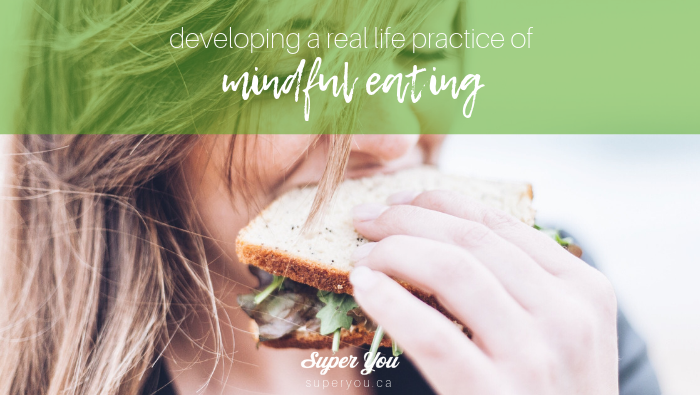Be honest. Have you ever sat down to watch a movie with a bowl of popcorn and before you know it your hand hits the bottom of the bowl? Yeah. Me too. Have you ever noticed how much you don’t notice eating?
It’s easy to get onto “autopilot” when you’re eating and multi-task away. The challenge with this? When you don’t notice what or how much you’re eating, it’s next to impossible to listen to your internal cues of fullness and satiety. Read: it’s super easy to over-eat! Or over-indulge on foods that while delicious may not be nutrient rich. This leads to an imbalanced plate and very possibly an unhealthy relationship with food.
What’s the solution?
It would be easy to say “just pay attention.” In fact, when the new Canada’s Food Guide was released recently one of the main recommendations was to “be mindful of your eating habits.” They clarified this to include “take time to eat,” and “notice when you are hungry and when you are full.” Which is awesome (I literally did a happy dance when I saw this was included)!
But is it really that simple? In my experience I would say yes…and no.
We live in a society that is perpetually multitasking and busy. Which means we rarely (if ever) just sit and eat. We eat while we scroll facebook, read a magazine, work, drive…
I would suggest there are multiple layers to why we shouldn’t do all this multitasking (ugh, there’s that shitty should again), but #reallife
Over the years I’ve come up with my own Real Life Practice of Eating Mindfully and I wanted to share the coles notes with you.
What does it mean to “eat mindfully?”
My personal definition as settled into this: eating mindfully is a practice of presence around food – not just in the choices I’m making, but why I’m making them, and how they are making me feel – both physically and emotionally!
How can I practice Mindful Eating?
STEP 1: Check in with your body – are you hungry?
- YES! Cool – answer these two questions:
- How hungry are you? Consider rating your hunger on a scale of 0-10. 0= so starved you’re weak or dizzy – you’re completely empty, 10= filled to the point of feeling sick.
- NO. No worries, this happens to everyone. Consider this question: what am I hungry for?
- What other needs am I trying to meet? How are you feeling mentally? Spiritually? How else might I meet those needs? This can be really helpful to think about in advance.
STEP 2: Choose Intentionally
- Thoughtfully choose your foods
- What do you need to satisfy your physiologic needs?
- What do you feel like eating that meets those needs?
- Remember this: NO judgement. Sometimes you’re going to nourish for your soul’s sake. That’s ok – in fact that’s part of a healthy relationship with food!
STEP 3: Eat mindfully
- Limit distractions: no screens, tablets or books – just eat. I know this isn’t always possible, but do your best to limit distractions especially in the first few bites and as you near fullness so you can pay attention to your internal cues!
- Notice: enjoy the textures and flavours of your food. Experience the food with all your senses!
- Eat with others: eating with others can help you slow down and enjoy the process more!
- Slow down! Did you know it takes your brain about 20 minutes to register fullness? If you eat too quickly you’re far more likely to overeat! Try putting your fork down between bites to help this.
- Savour: from start to finish savour the experience of eating.
- Stop when you’re full! Remind yourself you can have more later if you want more! This is especially important with “treat” foods that feel indulgent. Black and white diet mentality may have you trapped in the idea that this is your “last chance” with this food – but now that you’re not stuck in diet-mode you know differently! Yay!
The process of mindful eating is a powerful one. Start with ONE snack or meal, as you develop a skill set around this expand to more meals and snacks!
Want to take a deep dive on Mindful Eating?
Join me in the Super You Studio! In the Nutrition Masterclass I’ve got an entire lesson where we dig into this topic and I also include a handout to help guide you through the process and integrate it into your life!. Learn more here.
